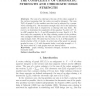Free Online Productivity Tools
i2Speak
i2Symbol
i2OCR
iTex2Img
iWeb2Print
iWeb2Shot
i2Type
iPdf2Split
iPdf2Merge
i2Bopomofo
i2Arabic
i2Style
i2Image
i2PDF
iLatex2Rtf
Sci2ools
CC
2006
Springer
2006
Springer
The complexity of chromatic strength and chromatic edge strength
The sum of a coloring is the sum of the colors assigned to the vertices (assuming that the colors are positive integers). The sum (G) of graph G is the smallest sum that can be achieved by a proper vertex coloring of G. The chromatic strength s(G) of G is the minimum number of colors that is required by a coloring with sum (G). For every k, we determine the complexity of the question "Is s(G) k?": it is coNP-complete for k = 2 and p 2-complete for every fixed k 3. We also study the complexity of the edge coloring version of the problem, with analogous definitions for the edge sum (G) and the chromatic edge strength s (G). We show that for every k 3, it is p 2-complete to decide whether s (G) k holds. As a first step of the proof, we present
| Added | 11 Dec 2010 |
| Updated | 11 Dec 2010 |
| Type | Journal |
| Year | 2006 |
| Where | CC |
| Authors | Dániel Marx |
Comments (0)

